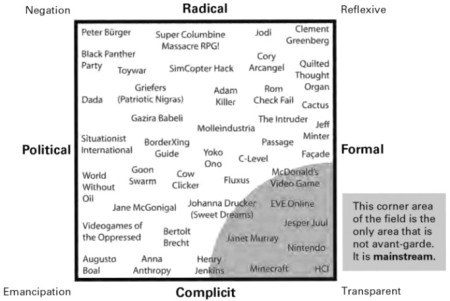This is my eighth monthly Patch Wednesday post where I discuss a question about video games that I think is unanswered, unexplored, or not posed yet. I will propose my own tentative ideas and invite comments.
The series is called Patch Wednesday to mark the sometimes ragtag and improvised character of video game studies.
It is easy, and probably common, to think of video game history as a series of innovations that propel video games “forward”, allowing for new experiences and expressions. (Not that anyone has written such a history in any significant detail.)
But what about in between? There are periods of time where, as I like to say, we know what video games are.
Four voices
When I took music classes in high school, I learned to do 4-voice arrangements of church hymns according a set of rules for harmony and voicing. Though it has later come in handy in weird ways, I can’t say that I appreciated learning those rules at the time, as it was rules about music that I did not care much for in the first place. In music theory, what I learned relates to the common practice period, ca 1600-1900, which is considered a stable period with certain rules about harmony, well-known chords and so on. One of the famous rules of the period is that two voices/instruments cannot follow each other in octave or fifth intervals. This was strange to me as I listened to much music, say Led Zeppelin, which often has the bass and the guitar playing riffs in unison.
I think I would have appreciated the lessons much more if I’d understood that the rules were a description of a particular musical style, and that all musical styles have sets of rules for what can and cannot be done.
Common practice periods in video games
And so it seems that video games have similar “common practice periods”, where video games, or at least certain video game genres, follow a set of rules. For example, the shooter genre is still in a common practice period where we expect a new game to contain both a single and multiplayer game, with the single-player game lasting between 10 and 30 hours for story-heavy games, and <10 hours for multiplayer-focused games. In addition, we expect such games to be promoted on ever “better” graphics, allow us to shoot firearms, collect more of them, manage ammunition, and so on.
In a bigger perspective, another common period was from 1980 to 2005 where we knew that video games were sold in boxes, aimed at a particular demographic, and (also) promoted on “better” graphics.
Does it follow that changing distribution models have bigger influence on the stability of game design than technology does?
And we can keep zooming out: When I was writing my game definition I dealt with the issue of change by not claiming that I had defined everything called games for all time, but rather that I was identifying a particular “classic game model” that had been dominant for several thousand years.
Institutions behind common practice
Going back to music, periods of stability may often have some institutionalized codification where rules are followed not only by observation, but may be explicitly taught to practitioners, and sometimes enforced. Video game educations and game design books can then also serve to define and maintain a period of common practice, though I suspect that many contemporary video game educations are more fascinated with breaking the rules than with maintaining them. Though that can become a type of common practice by itself, a “tyranny of pixelated platformers”.
That would be another type of history to write, one where we examine what it was that made certain periods of video game history so stable.


